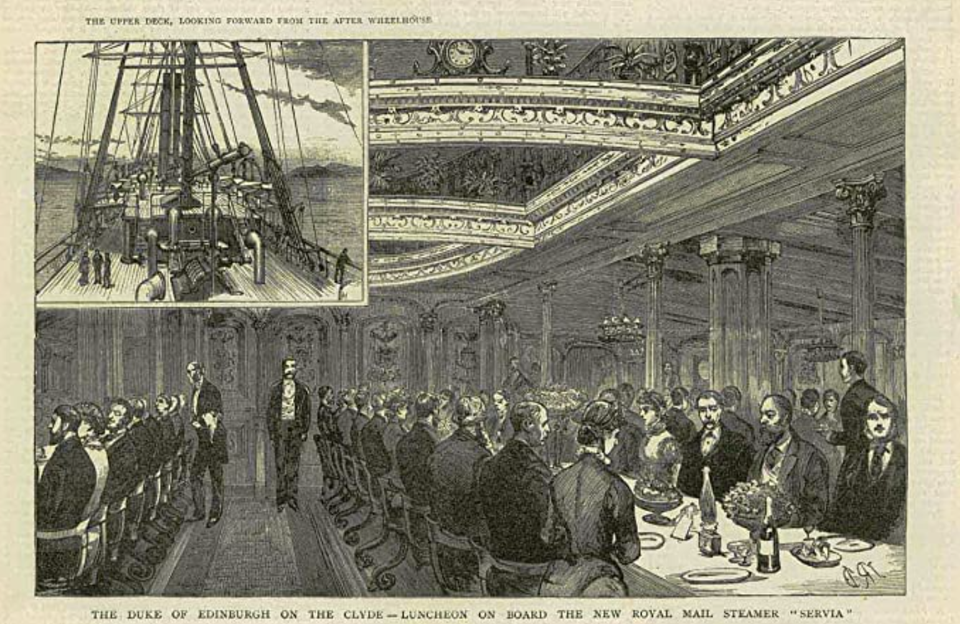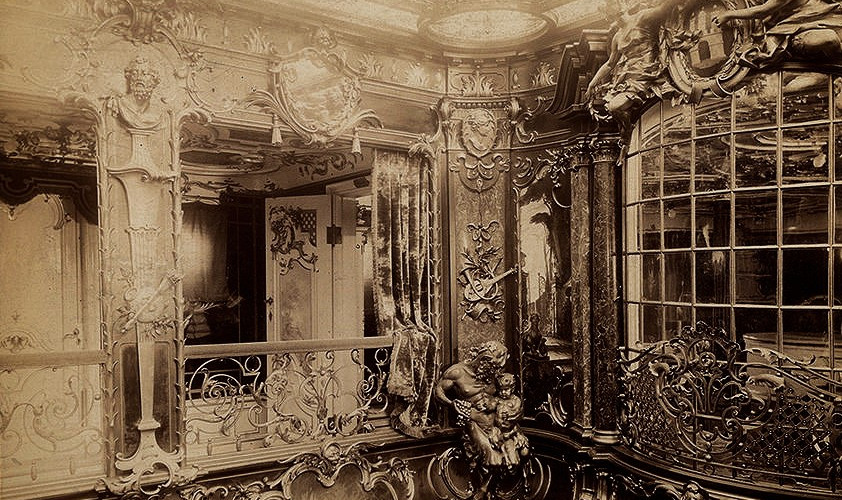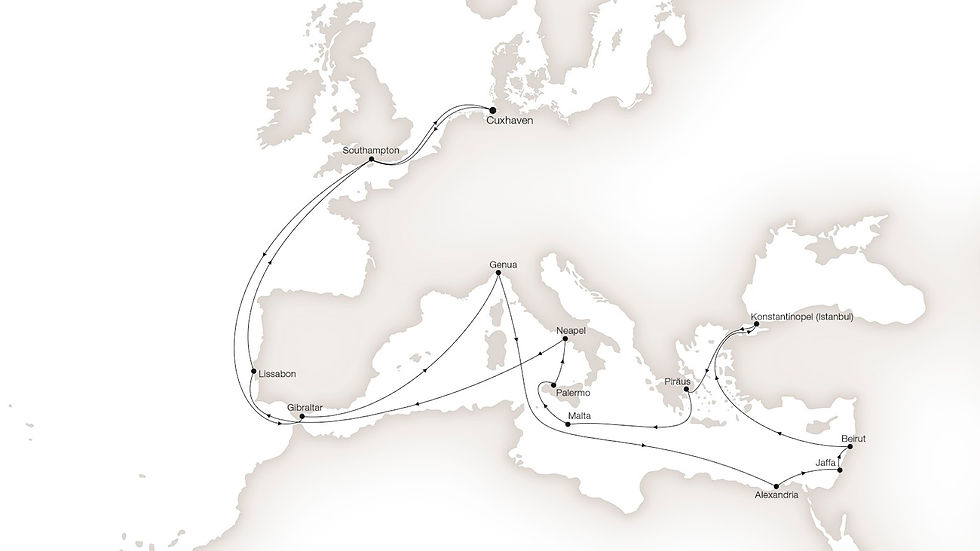Ballin's Gamble
- Jacob Lyngsøe

- May 12, 2020
- 10 min read
Updated: Jun 7
The first real luxury cruise in history.
The first leisure cruises in history were spartan affairs by today’s standards – the only parameter that even hinted at luxury was the price of the ticket. Ships were small and fragile, accommodation was basic, food and beverages were unsophisticated, and amenities and facilities very limited. It took significant advances in maritime engineering, ship design and experiential format before the cruise product matured to a point where you would even designate it a ‘real’ luxury cruise, both in the standards of creature comforts as well as elevated customer service. But if I had to point to a time in history when that first real luxury cruise became a reality, I would point to January 22, 1891.
Cuxhaven, Germany
The winter sun is shining from a clear blue sky but it is bitterly cold – a chilly Northern wind blows across the pier and crushed drift ice fills the harbour basin around the Steubenhöft pier. The 33-year-old Albert Ballin, Director of the Passenger Division at Hamburg Amerikanische Packetfahrt Actien-Gesellschaft (HAPAG), steps onto the bustling quayside, bracing against the cold, and looks up at his most daring enterprise yet. The black hull towering above the pier in front of him is that of the SS Augusta Victoria – an 8.479 GRT HAPAG luxury ocean liner – in full preparation for her imminent departure.
The ships orchestra is out on the pier in their dress uniforms, adding festive marches to the general din of departure. The last guests are still arriving - clearly high society, judging by their clothing, bearing and the copious amounts of luggage butlers and stevedores are hauling after them. Dock workers are busy loading supplies and prepping for departure, all the while cussing out the hundreds of gawkers and farewell-wishers crowding the pier to witness the spectacular sailaway. Up by the forward gangway a mix of imperial entourage and onlookers are restlessly milling about the stands from where Emperor Wilhelm II will see the ship off in a few hours time. Excited crowds are babbling, nervous horses are whinnying, brusque officers are shouting, steam whistles are blowing, the freezing orchestra is harmonising. There is excitement, jubilation and coal dust in the air. It is a momentous occasion.
A voyage of luxury
The cruise the Augusta Victoria was about to embark on was a 58-day Mediterranean cruise, calling at 11 ports from Lisbon to Beirut, plus a stop in Southampton out and back. There was nothing groundbreaking about the itinerary or the fact that an ocean liner was going on a cruise – that had all been done before. What was new was the sheer level of luxury involved; this was the first all-inclusive, luxury cruise. The ship had 2nd class and steerage accommodation too, but used only first-class cabins for this voyage. The 1.100 pax capacity ship would only carry 241 guests, which – given the crew of 245 – ensured a service ratio of better than 1:1. Fares ranged from 1.600 to 2.400 Goldmark p.p., the equivalent of EU 28.500 to 42.800 in today’s money – or in 1880’s economics, the equivalent of 2-3 times the annual household income of a working-class family. A cruise this expensive or this luxurious had never been offered before and consequently the passenger list was a veritable Who’s Who of Europe’s business elite, political establishment and aristocracy. Interestingly, the German contingent of guests were almost exclusively male – only Ballin himself brought his wife on board. Common (German) perception held that such long sea voyages would be ‘too strenuous for the womenfolk’. Had it not been for 64 intrepid British ladies joining in Southampton, the voyage would also have been the world’s first, luxury ‘sausage fest’ at sea.

This new concept had been Ballin’s brainchild and he must have felt equal parts vindication and trepidation at this moment. He had proven his many doubters wrong (including many of his fellow directors on the HAPAG board). People had scoffed at his idea of using the companys prestigious Atlantic liners for luxury leisure cruises in the off season for Atlantic crossings (liners were typically laid up in winter season when the Atlantic was too unpleasant to cross). No one would pay that much to go on a ship for that long in the midst of winter, they had objected. But they were wrong. The 241 boarding guests were living proof that the idea was attractive and marketable. But the most crucial question was yet to be answered: Would these 241 pioneer cruisers return with rave reviews, prompting a surge in demand for this newfangled holiday trend, or would they return unimpressed, even negative, at having blown so much time and money on a ‘boat ride’.
A man of vision
Having made a name for himself with the very successful establisment of the German Union Line, Ballin was hired by HAPAG in 1886 to head up the Passenger Division. Moving from the highly immigrant-centric dealings of the Union Line where volume had been the primary competitive parameter, Ballinn suddenly found himself in an market where the primary parameter was speed (and the prestige it brought) – All HAPAG and their foreign / domestic rivals cared about was speed; the fastest ship across the Atlantic won the Blue Riband, earned honor and glory for its operators and nation state, generated boatloads of PR and prestige in high society and increased operator profits by packing more crossings into a season.
While originating from commercial calculations, that focus on speed was taken to extremes by Imperial decree. When Germany's Kaiser Wilhelm II (and grandson of reigning Queen Victoria) attended the 1889 British Naval Review at Spithead, he was blown away by the maritime engineering, craftsmanship and performance on display, both from the Royal Navy and the British merchant fleet. While touring White Star Line's newest ship, the Teutonic, he was overheard saying 'We must have some of these!' and he returned to Germany with the strong determination that Germany should equal, or better yet, trump Great Britain in all matters maritime. Upon his return he called a meeting with the directors of Hamburg-Amerika Line and Norddeutscher Lloyd - the two biggest German shipping companies - to impress on them the importance of besting the British when it came to performance and grandeur of their ships. With speed of crossing already being a well-established success parameter (and an easy one to objectively measure), the directors left the meeting with the narrow-minded focus of 'getting there faster'.

But ‘getting there fast’ usually came at the expense of comfort, luxury and enjoyment for the passengers. To reach the required speeds, ships had to operate at the very limits of their technological envelopes, and in a time before advanced stabilizer and vibration dampener technology, this usually resulted in a crossing experience of excessive pitching, rolling and yawing and (depending on the quality of engineering) hull vibrations so severe they would spontaneously rearrange all furniture (and passengers) not secured to the deck, even in the mildest of sea conditions. Some ships were better than others but in general, a crossing experience at full speed was rarely a pleasant experience. The common philosophy seemed to be that crossings just had to be endured, never mind enjoyed, and that the best you could was just to make them as short as possible.

But Ballinn saw things differently. Realizing the futility of forever chasing the technological lead, he chose to focus on the 'grandeur parameter'. If guests could be delivered to their destination in a relaxed, delighted and even enriched frame of mind, they would surely not mind arriving a little later than the fastest ship. Ballinn argued that if ocean travel could be made sufficiently comfortable and luxurious to make guests choose comfort over speed, it would not only give HAPAG a competitive edge in passenger shipping, but potentially even turn into a luxury commodity in and of itself. To achieve that, he had to create an entirely new onboard experience – one that would wow the guests and trump any desire to get their destination faster. Inspired by his frequent stays at Europe’s finest luxury hotels, Ballinn went about trying to recreate the same standards of décor, luxury and service on his liners, to the point where guests would not be able to tell if they were in a luxury hotel ashore or at sea.

It was not as though luxury at sea was unheard of prior to Ballin's arrival. Shipping companies tried their best to make their passengers (in particular those of higher social circles) as comfortable and pampered as possible and from as early as the 1880's they were trying to project the image of 'floating hotels'. But it was definitely more within a 'form follows function' dogma, where practical, logistical and engineering considerations dictated the guest experience and not the other way around. Luxury was present in the spaces and in the forms that engineering allowed for and to the extent required to make the crossing experience bearable (according to the standards of your particular class), but rarely beyond that. No one had thought to change the game by radically amping up the experiential value with luxury and high-class service and adapting the engineering and logistics to fit, certainly not with the objective of turning the experience into a leisure product. But Ballin did and among his many achievements in the development of cruise tourism, this is perhaps the most all-encompassing: this 'hotelification' of passenger ships allowed them to transit from mere 'means of transport' to enjoyable 'travel experiences' in their own right in the public consciousness. A shift in perspective without which cruise tourism would pretty much have been unthinkable.
The floating hotel
The first ship to embody Ballin’s ‘floating hotel’ philosophy (and the Godmother of a subsequent trend of palatial interior design) became the Augusta Victoria in 1889, so the fact that she was even suited and equipped to pull off such a lengthy luxury cruise was already due to Ballin’s visionary foresight. Her interiors were without a doubt the most opulent at sea – spacious, stylish and ornate (at least in first class). The interior design could best be described as ‘aggressively rococo’ where every inch of surface is covered in elaborate ornamentation, curvy moulding, gilded cherubs, swirling scrollwork, frescoes, prisms and mirrors. The result was dizzying, but impressive in its consistency.
Interiors of the Augusta Victoria - wall-to-wall rococo
All first-class cabins and public spaces were arranged along the Oberdeck (top deck), with natural lights coming into the interior from wide skylights. Cabins were still small (because this was still primarily an ocean liner and the profit lay in getting as many people as possible from A to B), but they were exquisitely appointed. Hard as it is for us to imagine about a ‘luxury cruise’, in-cabin plumbing still was not a thing in 1891 – toilets and bathrooms were communal and a designated bath steward helped guests coordinate their daily ablutions. Besides the large dining room forward, the ship featured a number of smaller lounges for smoking (men), writing (women) and music and also a reception area by the grand staircase.
Cruise hallmarks pioneered
Ever the publicity hound, Ballin had invited representatives from German and international press on board, ensuring that the whole world could follow along in the fantastic journey. Together with these journalists and an illustrator, he also pioneered another hallmark of the cruise experience; the on board newspaper or daily bulletin – a forerunner to today’s Daily Program. Another essential component of the cruise experience that Ballin pioneered was the role of the ‘cruise director’. There were no dedicated ‘cruise staff’ on board but eager to ensure his guests’ enjoyment at all times, Ballin inserted himself as MC, host or commentator in every single event, party or function on board. Whatever the event, Ballin was always there; presenting with flourish, leading cheers, boosting spirits, patting backs, shaking hands and providing a sense of occasion – much like any other cruise director would today.
So when the Augusta Victoria pulled away from the pier that cold January-day, she was heading out on an unparalleled leisure experience on board the most luxurious accommodation afloat with sumptuous, all-inclusive gourmet fare, exquisite customer service, cultured company, exotic destinations, exclusive shore excursions and a young HAPAG director working tirelessly to elevate the experience at every turn.
A triumphant return
So, was the world’s first luxury cruise eventually deemed a success? Most definitely! The SS Augusta Victoria returned back to Cuxhaven on March 19, 1891, with an almost equal amount of fanfare. The cruise had lasted 57 days, 11 hours and 3 minutes. As soon as she had docked, the press delegation rushed off to their respective offices to finish and publish their rave reviews and the high society scattered with equal rush to their respective social circles to brag of the amazing experience they had just enjoyed. Word spread like wildfire that ‘luxury cruising’ was the ‘new black’ for the socialites, bon vivants and magnates of the age. No one on the HAPAG board of directors could refute the tremendous success of Ballin’s gamble, in terms of profit, popularity or publicity, and from this point on it became standard procedure to schedule the company's Atlantic liners for pleasure cruises, so-called Gesellschaftsreisen (‘Society journeys’ – the ‘high’ was implied) in the winter season - a practice which competing shipping companies soon began to imitate. The luxury cruise had come to stay.
That didn’t stop the other HAPAG directors from continuing to underestimate Ballin’s vision. Even after he made managing director in 1899 and announced he would now construct a ship exclusively for luxury pleasure cruising, they sniggered amongst themselves; ‘Now the megalomaniac is building his own luxury yacht..’ … but that’s a story for a different time.
This is the seventh article in a series of historical retrospectives on the history of cruising prior to the industry formation in the 1960's. Although not academic papers, the articles are researched to the extent of my resources and ability and strive to be as historically factual as possible. If you enjoyed it, feel free to like, share or comment and follow me (or The Cruise Insider) for more instalments.
P.S. Want to know how the cruise itself went? The press reports on the voyage from two German newspapers have been compiled into a book; Die Orient-Reise Der Augusta Victoria Vom Januar Bis März 1891 by H. Wenth, Wentworth Press. Reproduction available on Amazon, but it does require you to be able to read German... in a Gothic font style.




























Comments